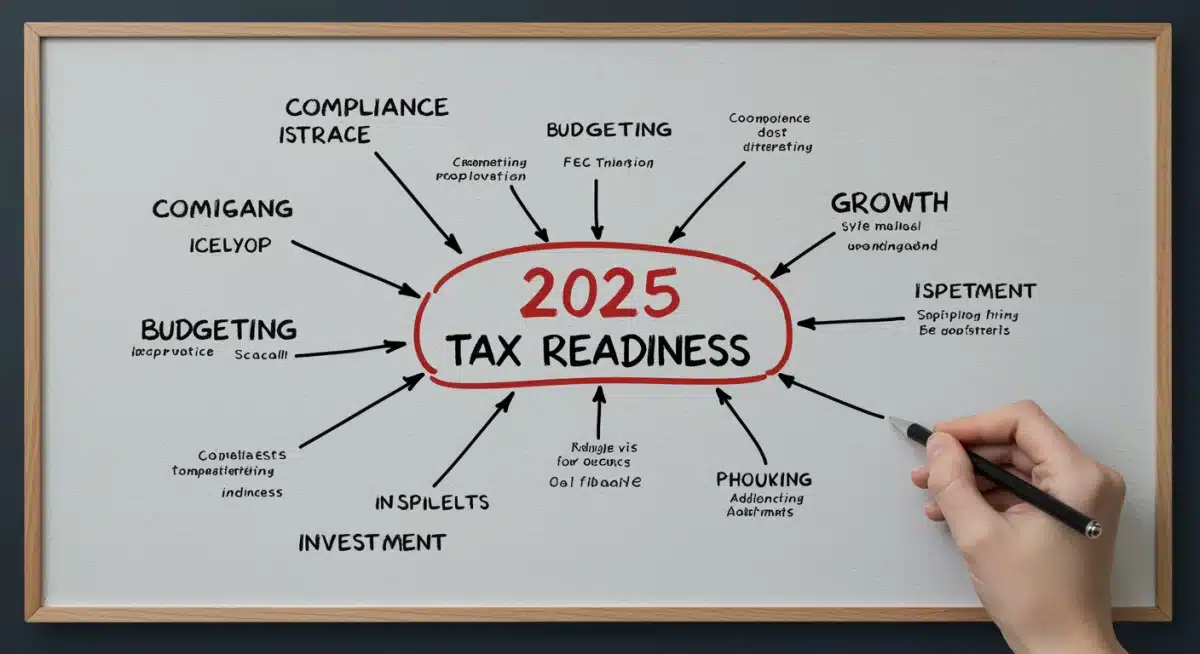U.S. Corporate Tax Reforms 2025: 15% Minimum Tax Impact

The anticipated U.S. corporate tax reforms for 2025, featuring a new 15% minimum tax, will significantly alter financial landscapes for small businesses and mid-market companies, necessitating immediate strategic reevaluation.
As 2025 approaches, businesses across the United States are keenly watching the horizon for significant changes. The impending
Understanding the 15% Corporate Minimum Tax
The 15% corporate minimum tax, often referred to as the Corporate Alternative Minimum Tax (CAMT), is a crucial component of the broader U.S. corporate tax reforms for 2025. This tax aims to ensure that large, profitable corporations pay a minimum amount of tax, regardless of the deductions, credits, and accounting maneuvers they might employ. While initially targeting the largest enterprises, its ripple effects can certainly extend to other segments of the business landscape.
This isn’t merely an incremental adjustment; it’s a structural change designed to close perceived loopholes and foster greater equity in the tax system. For businesses, particularly those with complex financial structures or significant tax incentives, understanding the mechanics of this minimum tax is paramount. It introduces a new layer of calculation and compliance that can dramatically impact a company’s effective tax rate and, consequently, its bottom line.
The Genesis of the Minimum Tax
The concept of a minimum tax isn’t new, but its application in the current U.S. corporate tax reforms for 2025 reflects a modern response to evolving economic landscapes and public demands for fairer taxation. It stems from concerns that some highly profitable corporations were paying little to no federal income tax.
- Historical Context: Previous iterations of minimum taxes existed, but the 2025 version is tailored to current corporate accounting practices.
- Policy Objectives: The primary goal is to increase tax revenue and ensure corporations contribute their fair share, regardless of book-to-tax differences.
- International Influence: The global push for a minimum corporate tax rate, often discussed in international forums, has also played a role in shaping domestic policy.
In essence, the 15% minimum tax acts as a floor. If a corporation’s regular tax liability, after all deductions and credits, falls below 15% of its adjusted financial statement income, it must pay the difference as a minimum tax. This means companies can no longer rely solely on traditional tax planning strategies without considering this new threshold. The implications for financial reporting and strategic planning are profound, demanding a comprehensive review of current practices to ensure readiness for 2025.
Defining “Small Businesses” and “Mid-Market Companies” in the Context of Tax Reform
When discussing the U.S. corporate tax reforms for 2025, it’s essential to clarify what constitutes “small businesses” and “mid-market companies.” These terms, while commonly used, can have varying definitions depending on the context, particularly in tax legislation. The applicability of the 15% minimum tax hinges significantly on these classifications, making a precise understanding critical for any enterprise evaluating its potential exposure.
Generally, small businesses are characterized by their revenue, number of employees, or asset base, often falling below specific thresholds set by government agencies like the Small Business Administration (SBA). Mid-market companies typically occupy the space between small businesses and large enterprises, distinguished by higher revenues and employee counts than small businesses but lacking the global scale of multinational corporations. The nuances in these definitions are crucial for businesses trying to ascertain their position relative to the new tax laws.
Revenue Thresholds and Employee Counts
The applicability of the 15% minimum tax is primarily tied to a company’s average annual adjusted financial statement income. This threshold is specifically set to capture larger entities, but its indirect effects can still be felt by smaller players.
- For the 15% Minimum Tax: The current legislation targets corporations with average annual adjusted financial statement income exceeding $1 billion over a three-year period.
- Defining Small Businesses: Often, entities with annual revenues under $5 million to $50 million, or fewer than 500 employees, are categorized as small.
- Defining Mid-Market Companies: These typically have annual revenues ranging from $50 million to $1 billion, or between 500 and 5,000 employees.
While the direct application of the 15% minimum tax may not immediately affect most small businesses or even many mid-market companies due to the high revenue threshold, the broader economic and competitive landscape will undoubtedly shift. Suppliers, partners, and customers of these larger corporations may find themselves indirectly impacted. Therefore, even if a company doesn’t meet the direct criteria, understanding the implications of the U.S. corporate tax reforms for 2025 remains a strategic imperative, fostering preparedness for potential market adjustments and evolving business relationships.
Direct and Indirect Impacts on Small Businesses
Though the 15% minimum tax is largely aimed at corporations with over $1 billion in financial statement income, small businesses are not entirely immune to the ramifications of the U.S. corporate tax reforms for 2025. The economic ecosystem is interconnected, and significant changes at the top often cascade down, influencing market dynamics, supply chains, and even access to capital. Small enterprises must therefore remain vigilant and understand these potential indirect effects.
Directly, most small businesses will likely not owe the 15% minimum tax. However, the indirect impacts can manifest in various forms, from altered consumer spending patterns due to broader economic shifts, to changes in corporate client behavior. For instance, large corporations adjusting their financial strategies to comply with the new tax might re-evaluate their vendor relationships or investment priorities, inadvertently affecting their smaller partners and suppliers. This necessitates a proactive approach to business planning and risk assessment.
Supply Chain Adjustments and Pricing Pressures
Large corporations, under pressure from the new minimum tax, may seek ways to optimize their costs, which could lead to renegotiations with their suppliers, many of whom are small businesses.
- Vendor Review: Major clients might scrutinize their vendor lists more closely, seeking efficiencies where possible.
- Pricing Demands: Small business suppliers might face increased pressure to lower their prices or offer more competitive terms.
- Operational Efficiency: This could necessitate small businesses to improve their own operational efficiencies to maintain profitability.
Furthermore, changes in the overall tax burden on large corporations could influence their investment in innovation, research, and development, areas that often create opportunities for small business collaborators. Small businesses should assess their reliance on larger corporate clients and explore diversification strategies to mitigate potential risks associated with these shifts. Staying informed about the broader implications of the U.S. corporate tax reforms for 2025 is crucial for navigating these turbulent waters and ensuring continued stability and growth.
Navigating the New Tax Landscape for Mid-Market Companies
Mid-market companies, while generally having a larger financial footprint than small businesses, also need to carefully analyze the U.S. corporate tax reforms for 2025. While many may not directly meet the $1 billion revenue threshold for the 15% minimum tax, the reforms introduce a new layer of complexity and potential strategic considerations. Their position in the economic hierarchy means they often interact with both smaller businesses and larger corporations, making them particularly sensitive to shifts in the broader tax environment.
For some mid-market companies on the cusp of the $1 billion threshold, the 15% minimum tax could become a direct concern in the near future, especially if they experience rapid growth or engage in certain types of M&A activities. Even for those well below the threshold, the reforms necessitate a re-evaluation of financial planning, investment strategies, and potential mergers or acquisitions. Understanding how larger competitors are adapting can also provide valuable insights into evolving market conditions and competitive strategies.

Strategic Planning and Financial Modeling
Mid-market companies must engage in robust financial modeling to understand their potential exposure and how the U.S. corporate tax reforms for 2025 might impact their effective tax rate and cash flow.
- Scenario Analysis: Develop various financial scenarios to project tax liabilities under different growth trajectories and operational changes.
- Book-to-Tax Differences: Pay closer attention to differences between financial statement income and taxable income, as these are critical for the minimum tax calculation.
- Investment Decisions: Re-evaluate investment in assets or projects that rely heavily on tax credits or accelerated depreciation, as these might be less beneficial under the new regime.
Furthermore, mid-market companies often have more sophisticated tax departments or external advisors than small businesses, allowing for more detailed analysis and proactive adjustments. Engaging with tax professionals early is crucial for identifying potential risks and opportunities. The goal is not just to comply but to strategically position the company for continued success within the evolving fiscal framework of the U.S. corporate tax reforms for 2025, ensuring that growth is sustainable and profitable amidst new tax obligations.
Compliance Challenges and Reporting Requirements
The U.S. corporate tax reforms for 2025, particularly the 15% minimum tax, introduce a new layer of compliance challenges and reporting requirements that extend beyond simply calculating a new tax liability. Even if a business doesn’t directly owe the minimum tax, understanding the reporting mechanisms and the data points required for compliance is essential. This is not just about avoiding penalties but about maintaining accurate financial records and transparency.
The new rules will necessitate a closer alignment between financial accounting (book income) and tax accounting, a divergence that has historically been a source of complexity. Companies will need to reconcile these differences more rigorously, potentially requiring updates to their accounting software, internal processes, and even staff training. The shift demands a more integrated approach to financial and tax reporting, emphasizing precision and a thorough understanding of the adjusted financial statement income calculation.
Data Collection and System Updates
Meeting the new reporting requirements for the 15% minimum tax will demand enhanced data collection capabilities and potentially significant system updates for affected companies.
- Adjusted Financial Statement Income: Companies must accurately track and report their adjusted financial statement income, which forms the basis for the minimum tax calculation.
- Software Solutions: Investment in new accounting or tax software might be necessary to handle the complex calculations and reporting nuances of the U.S. corporate tax reforms for 2025.
- Internal Controls: Strengthening internal controls over financial reporting will be critical to ensure accuracy and compliance with the new tax regime.
For mid-market companies, this could mean allocating additional resources to their finance and accounting departments or engaging external tax experts with specialized knowledge of the new regulations. Small businesses, while less directly impacted, should still be aware of these changes, particularly if they aspire to grow into the mid-market segment or engage with partners who are directly affected. Proactive preparation and understanding the intricacies of the U.S. corporate tax reforms for 2025 are key to mitigating compliance risks and ensuring a smooth transition into the new tax environment.
Strategies for Adaptation and Future Planning
Adapting to the U.S. corporate tax reforms for 2025, especially the 15% minimum tax, requires more than just understanding the rules; it demands strategic foresight and proactive planning. Businesses, regardless of their size, need to develop comprehensive strategies to mitigate potential negative impacts and leverage any opportunities that may arise from the changing tax landscape. This involves a holistic review of operations, financial structures, and investment portfolios.
For small businesses, adaptation might mean exploring new market segments, optimizing operational costs, or seeking out new partnerships that are less exposed to the indirect effects of the reforms. Mid-market companies, on the other hand, might focus on re-evaluating their capital expenditure plans, scrutinizing their use of tax credits, and engaging in more sophisticated tax planning. The key is to move beyond mere compliance and integrate tax considerations into the core of business strategy, fostering resilience and sustainable growth.

Key Adaptation Strategies
Successfully navigating the U.S. corporate tax reforms for 2025 involves several strategic approaches, tailored to the specific circumstances of each business.
- Early Engagement with Tax Advisors: Consulting with tax professionals specializing in corporate tax law is paramount to understanding specific implications and developing tailored strategies.
- Financial Health Check: Conduct a thorough review of current financial statements, projections, and tax positions to identify areas of potential exposure or advantage.
- Operational Efficiency Review: Look for opportunities to streamline operations and reduce costs, which can help offset any increased tax burdens.
- Investment Re-evaluation: Assess how existing or planned investments in R&D, capital assets, or other areas might be affected by changes in tax incentives or the minimum tax.
Furthermore, businesses should consider the long-term implications of these reforms on their competitive position. Will competitors be more or less affected? How might customer and supplier relationships evolve? By asking these questions and proactively seeking answers, businesses can develop robust plans that not only ensure compliance with the U.S. corporate tax reforms for 2025 but also position them for continued success and adaptability in a dynamic economic environment. This forward-looking approach is essential for thriving amidst fiscal change.
Long-Term Outlook and Economic Implications
The U.S. corporate tax reforms for 2025, particularly the 15% minimum tax, are not merely short-term adjustments; they represent a significant shift with long-term economic implications. These reforms are expected to influence everything from corporate investment decisions to global competitiveness and the overall economic landscape. Understanding this broader context is crucial for small businesses and mid-market companies to anticipate future trends and plan accordingly.
In the long run, the minimum tax could lead to a more level playing field by reducing aggressive tax planning, potentially fostering a fairer competitive environment. However, it could also influence where corporations choose to invest, innovate, and even locate their operations. The cumulative effect of these individual corporate decisions will shape economic growth, job creation, and investment patterns for years to come. Businesses need to consider these macro-level implications when charting their strategic course.
Potential Shifts in Investment and Innovation
The new tax environment could alter the incentives for corporate investment, especially in areas that previously relied heavily on specific tax breaks.
- Capital Allocation: Companies might reallocate capital from areas with diminishing tax benefits to those that offer better post-tax returns.
- R&D Spending: While R&D incentives generally remain, their relative attractiveness might shift compared to other investment opportunities under the new minimum tax.
- Global Competitiveness: The reforms could influence the U.S.’s attractiveness for foreign direct investment and how U.S. companies compete internationally.
Additionally, the revenue generated from the 15% minimum tax could be directed towards various public initiatives, which might indirectly benefit businesses through improved infrastructure, education, or other government programs. However, the immediate focus for businesses must be on adapting to the new tax reality and understanding its direct and indirect financial consequences. The U.S. corporate tax reforms for 2025 underscore the importance of continuous monitoring of legislative developments and economic indicators to ensure long-term resilience and strategic positioning in an ever-evolving market.
| Key Aspect | Brief Description |
|---|---|
| 15% Minimum Tax | Ensures large corporations pay at least 15% of their adjusted financial statement income, impacting those over $1B. |
| Small Business Impact | Primarily indirect, through supply chain adjustments and broader economic shifts from larger company reactions. |
| Mid-Market Strategy | Requires robust financial modeling, re-evaluation of investments, and proactive tax planning, especially for growth-oriented firms. |
| Compliance Challenges | Demands enhanced data collection, system updates, and stronger internal controls for accurate reporting. |
Frequently Asked Questions About 2025 Corporate Tax Reforms
The 15% corporate minimum tax primarily impacts corporations with average annual adjusted financial statement income exceeding $1 billion over a three-year period. This threshold means that most small businesses and many mid-market companies will not be directly subject to this specific tax.
Small businesses may experience indirect impacts through shifts in supply chain dynamics, pricing pressures from larger clients adjusting to new tax burdens, and broader economic changes. These ripple effects necessitate proactive business planning and diversification to maintain stability.
Mid-market companies should conduct thorough financial modeling, re-evaluate investment strategies, and pay close attention to book-to-tax differences. Engaging with tax advisors early and updating accounting systems are crucial steps for effective preparation and compliance.
Yes, the reforms introduce new compliance challenges, requiring companies to accurately track and report their adjusted financial statement income. This may necessitate investments in new software, updates to internal processes, and stronger internal controls for financial reporting accuracy.
Long-term implications include potential shifts in corporate investment, innovation, and global competitiveness. The reforms aim for fairer taxation and could influence economic growth patterns, job creation, and the overall business environment for years to come.
Conclusion
The U.S. corporate tax reforms for 2025, particularly the 15% minimum tax, mark a significant turning point in the nation’s fiscal policy. While directly targeting large corporations, the cascading effects will undoubtedly resonate across all business segments, including small businesses and mid-market companies. Proactive understanding, strategic planning, and adaptive measures are not just recommendations but necessities for navigating this evolving landscape. By staying informed and engaging with expert financial advice, businesses can transform potential challenges into opportunities, ensuring resilience and sustained growth in the face of these monumental tax changes.





